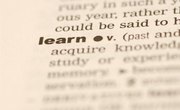Tip
When teaching the eight parts of speech for kids, consider using simple word games so kids can work together while learning.
The eight parts of speech for kids are the essential building blocks to teaching kids proper grammar. The English language has approximately 250,000 distinctive words and each of these words can be divided into eight parts of speech. Teaching the eight parts of speech allows children to learn and execute proper sentence structure.
Subject Matter Parts of Speech
A noun is a person, place, thing, animal, activity, quality or idea. Examples of nouns are "cat," "dog," "girl," "paper," "desk," "library," "honesty" and "swimming." If the noun as a part of speech for kids is a specific person, place or thing, such as "Chicago," "Wisconsin," "Kyle," "Allyssa," "Empire State Building," "Tuesday" or "January," the noun is considered a proper noun. A proper noun as part of speech in elementary class always begins with a capital letter. Nouns that do not refer to a specific name of a person, place or thing are called common nouns.
A pronoun is a word that takes the place of a noun. There are five types of pronouns: personal ("I," "me," "our," "you," "his," "her" and "its"), relative ("who," "what" and "that"), indefinite ("all," "anyone," "both," "everything," "much," "nothing," "several" and "someone"), interrogative (words that begin a sentence, such as "who" and "whom") and demonstrative ("this," "these" and "those"). Examples of parts of speech activities consist of using concept mapping, diagrams and graphic organizers. For instance, you can use butcher paper or large self-adhesive paper to write examples of nouns and pronouns. Then, kids offer as many names as possible until you fill the paper.
Description Parts of Speech
A verb is a word that states an action or state of being. Examples of action verbs are "run," "eat," "throw," "play," "write" and "talk." There are many types of verbs used as parts of speech with elementary students. Verbs can be past, present and future tense, such as in "Kyle ran," "Kyle is running" and "Kyle will run." Some verbs are considered linking verbs. Linking verbs, such as "is," "be," "am," "are," "was" and "were," link a noun to a description of that noun; they connect a noun or subject to a noun or adjective.
Helping verbs are used before an action or linking verb. Examples of helping verbs are "could," "can," "was," "has" and "did." An adverb modifies an adjective, verb or another adverb. An adverb explains a time, place, manner or degree. As parts of speech for kids, adverbs are used to describe how, when, where, how often and why something happens. Adverbs often end in "ly."
Examples of adverbs are "loudly," "easily," "carefully," "correctly," "quickly," "in," "out," "never," "usually," "after," "now," "soon," "here" and "there." An adjective is a word that describes a noun. In the English language, adjectives often go before the noun, or they go after a verb. Examples of adjectives are "blue," "wooden," "fast," "old," "short" and "big."
More fun ways to use parts of speech activities for kids is a scavenger word hunt. For instance, select one of your favorite stories in class. Then, choose verbs, adverbs and adjectives from the story. Next, write the words on a piece of paper, cut them out and hide them around the classroom. After reading the story, tell the kids to hunt for the words.
Connections Using Parts of Speech
A preposition is a connecting word that shows the relation of a noun or pronoun to another word. Examples of prepositions are "for," "on," "to," "from" and "at." A preposition is the beginning of a prepositional phrase. A prepositional phrase as part of speech for kids is the entire part of the sentence that describes the noun. For example, "Allyssa danced for an hour" contains the prepositional phrase "for an hour." "For" is the preposition.
Conjunctions are words that join other words together. There are three types of conjunctions; coordinating, subordinating and correlative. Coordinating conjunctions connect a word to a word, a phrase to a phrase or a clause to a clause. They are often used to connect two independent clauses in compound sentences as part of speech in elementary activities.
Examples of coordinating conjunctions are "and," "but," "for," "or" and "so." Subordinating conjunctions are often used in complex sentences that contain an independent and a dependent clause. They show the relationship between the clauses. Examples of subordinating conjunctions are "although," "as though," "though," "until" and "whereas."
Correlative conjunctions work in pairs to join words of an equal importance. Examples of correlative conjunctions are "not only" and "but," "either" and "or," "neither" and "nor" and "whether" and "or." Interjections tell emotion or a surprise. Interjections are often followed by an exclamation mark. Examples of interjections are "Oh no!," "Oh my goodness!" and "Ah, yes!" Other fun parts of speech activities include fill in the blank word games.
In this case, encourage students to work together with specific prepositions, conjunctions or interjections. Then, write different sentences on the board leaving out the connection word. Next, motivate kids to use their words in different ways by swapping their word cards with other children in the class.
Related Articles
References
Writer Bio
Angela M. Wheeland specializes in topics related to taxation, technology, gaming and criminal law. She has contributed to several websites and serves as the lead content editor for a construction-related website. Wheeland holds an Associate of Arts in accounting and criminal justice. She has owned and operated her own income tax-preparation business since 2006.










